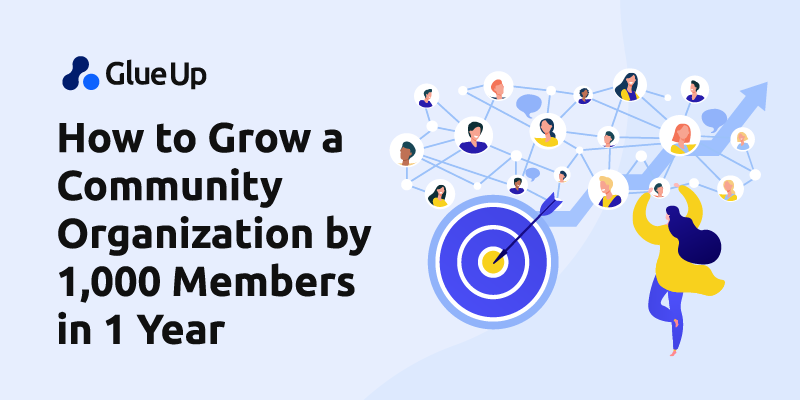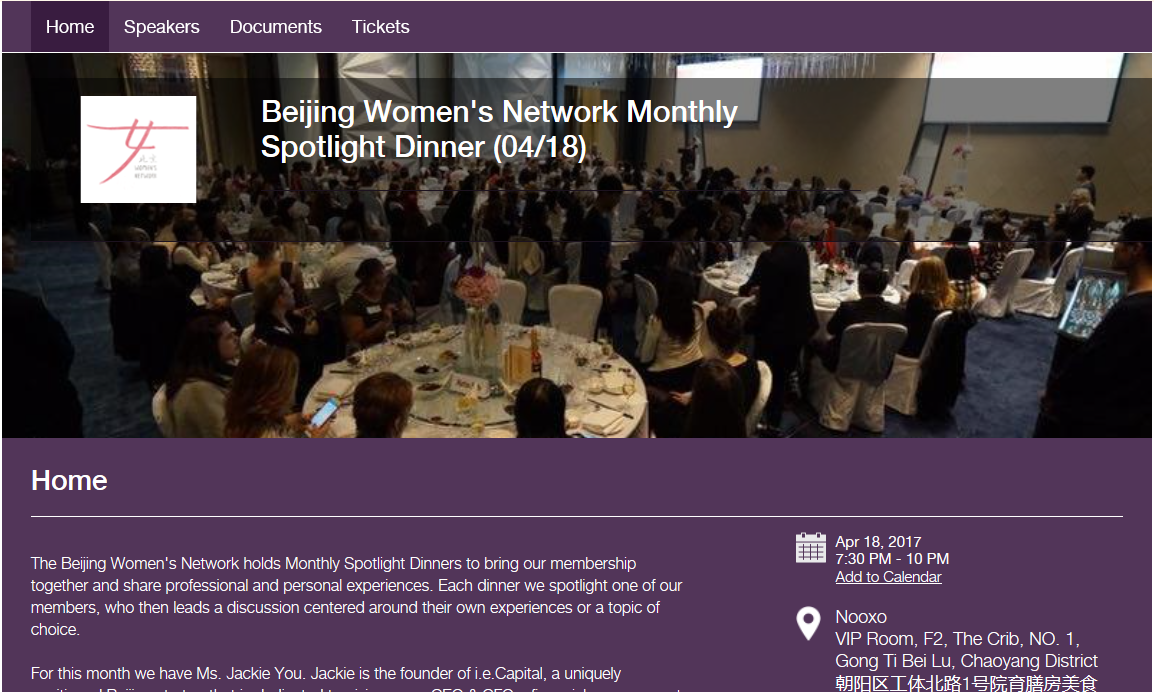
Glue Up is proud to present a spotlight on one of it's most impressive and astoundingly growing organizations using it's one of a kind all-in-one engagement software platform. They were able to grow 1000 members strong after it's inception using Glue Up, and through their success comes the fruits of insightful learning. See how this unassuming women's organization made a splash and captures members exponentially, and learn how to grow a community of over 1000 members in less than a year.
Glue Up Spotlight: The Beijing Women's Network
The Beijing Women’s Network was founded in March 2015 by a group of 12 women brought together by a mutual interest in discussing women’s issues. By December 2016, the network had over 1,300 young professionals and 1,000 women attending events throughout the year. How did an organization led by a group of young professional volunteers grow by over 1,000 members in one year?
In one sentence: We developed a successful leadership structure, executed four quality monthly event series, and utilized technology to increase efficiency and build organization infrastructure. < h2>Fostering Leadership
"Some of my most rewarding experiences with the BWN has been watching the way the leadership has grown into itself". Lily Rogers, Co-Chair of the Healthy Living Series
At the beginning of 2016, we established the Leadership Council and each member was assigned as a co-chair to one event series that would run throughout the whole year. The most important lesson we learned was giving all our volunteers ownership. This was crucial in regards to holding our leadership council accountable for their organization responsibilities and making sure the work got done.
It was important to make our volunteers feel that this was this organization and that they have a voice and decision-making power. In addition, they were passionate about the projects they worked on because they aligned with their personal and professional interests and matched their current skills and skills they wanted to improve.
For women who were highly involved in the organization, we created the “Brand Ambassador” role. These women wanted to play a more active role in the organization and were interested in dedicating their time, resources, connections, and skills to growing and promoting the initiatives of the organization. Both brand ambassadors and Leadership Council attended our monthly planning meetings where we would coordinate for upcoming projects, events, and administrative tasks. Over 40 Brand Ambassadors played a vital role in executing our first Annual “Women in Leadership” Gala on November 11th, 2016.
The tone of our organization always remained consistent: strive to be the best versions of ourselves through community building, knowledge sharing, positivity, and helping others. Through running these events, we all sharpened our public speaking, event and organization management, and leadership abilities which made us better at our full-time jobs.
Organization Leadership Takeaway:
- Give volunteers specific tasks and responsibilities that fit into their personal and professionals goals.
- You need to provide value, show appreciation, and create opportunities for growth and professional development for everyone involved in your organization.
Running Quality Event Series
Initially, the original three administrators coordinated all of the different tasks for all the events series. This changed after establishing the Leadership Council and our events ran much more efficiently as our admins had more concrete roles. Through our Healthy Living, Professional Development, Pregnant, Marriage, and Motherhood (PMM) dinners, and Spotlight dinners, we were able to cover a diverse range of topics affecting the personal and professional lives of our members.
Every woman led a series that overlapped with their current position, career goals, and interests. Samantha Kwok, CEO of JingJobs, and I co-chaired the Professional Development Series as our day job were related to strengthening soft and hard skills from networking to Chinese social media.
Samantha emphasized “the more I got involved the more I realized how many young professionals who genuinely needed advice, mentorship and answers to some of their professional development questions that were not getting answered or addressed in their current work environments”.
As a headhunting expert, Sam organized a “Changing Jobs and Industries” panel. As the marketing coordinator for a software company, I organized our “Women in Technology” panel highlighting women leaders in China’s start-up and corporate ecosystem. Being young professionals, we were able to choose and control every aspect of the event based on the issues and topics that we were most interested in.
We used our network to find expert speakers and ensured we prepped them with panel questions and any additional information they needed. We collected feedback from every event and incorporated it into the next events. As we ran more events, we added interesting components and add-ons for our “Personal Branding and Professional Confidence” event. We took a lot of pride in our events and worked hard to make sure that they were a reflection of Beijing Women’s Network values and purpose.
Event Management Takeaways:
- The main focus of your events should be providing value for your community, sharing knowledge, and building authentic relationships.
- Having event series instead of one-off events helps to build brand awareness and consistency.
Utilizing Technology
Everyone in Mainland China is connected through an all-in-one, multi-function social media platform called WeChat that integrates messaging, a newsfeed, and online payment for products and services. Through our WeChat groups and the Glue Up platform, we were able to easily engage our community and efficiently manage our organization. Beijing Women’s Network began as a WeChat group that shared events and job descriptions as well as provided professional support relating to living, working, and being a woman in Beijing. Our WeChat accounts along with our event series consistently provided value and a sense of community for our members.

We created a standard message when new members were added that introduced them to the network and admins, set rules for the group’s discussion, and everyone on Leadership Council would moderate the groups accordingly. Through word of mouth, new members were added to the Beijing Women’s Network groups. As we expanded, we had to open up two more groups as each WeChat group has a 500-person maximum.
Our WeChat platform allowed us to easily engage our members but we were wasting a lot of time on manual labor and none of our contacts, events, or email campaigns were tracked or centralized. We began our technology partnership with Glue Up, an all-in-one platform that integrates event and membership management, email campaigns, online payment, and CRM, in December 2015. The goal was to have 500 members by the end of the year and we surpassed that number in March 2016 by doubling our organization in size after 3 months of using the platform. We exceeded 1,000 members three months later in July 2016.
This new system cut out several inefficient manual practices and allowed us to run a high volume of professional events. We were able to promote our events through WeChat, accept online registration and payment, and use mobile check-in for all events. The professional event websites could be shared through WeChat moments and groups as well as various of other social media channels.
Through the CRM, we could account for the growth or our organization as event attendees were automatically tracked. It gave us the infrastructure to grow as new volunteers could easily use the platform and start working on new projects. Another benefit of utilizing technology for your organization is establishing legitimacy and expanding your reach within your community.
Utilizing Technology Takeaway:
- Social media is the best way to connect with your community and share and promote what your organization is doing as well as job opportunities, upcoming events, articles, and resources.
- Running a community organization can be time-consuming and involve a lot of manual processes. There are many different existing free or affordable websites, services, or platforms that can make running your organization a lot more efficient.
Conclusion
Through all of our events, we were able to raise 20,000 RMB in 2016 for our charity, the United Family Foundation and make a positive impact on the lives of over a thousand foreign and Chinese women. As a result of the experiences growing our organization, our Leadership Council grew into confident leaders capable of running a network of this size. In one year, Beijing Women’s Network became one of the most active professional international communities in Beijing through utilizing technology, building a leadership structure that consistently provided value for our volunteers, and running meaningful and useful events for our members.




